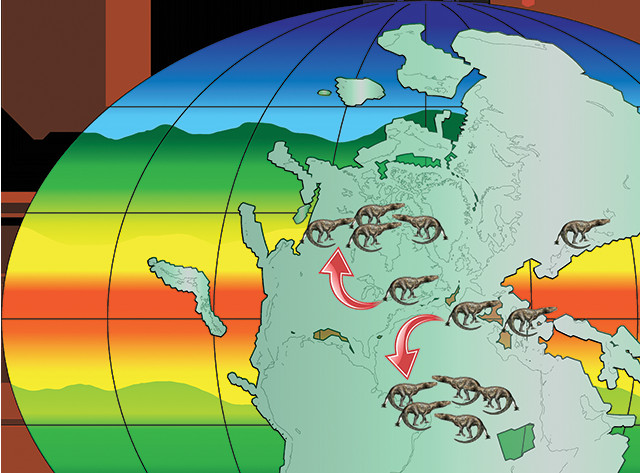
by Bethany Augliere Tuesday, April 10, 2018

Terrestrial reptiles vacated the tropics (orange and yellow belts) following the end-Permian mass extinction 252 million years ago. Credit: MUSE Archive.
About 252 million years ago, massive volcanic eruptions in what is now Siberia rapidly warmed Earth, resulting in the end-Permian mass extinction that saw most terrestrial and marine species die off. It’s been thought that surviving reptiles and fish fled the hot tropics and didn’t return for millions of years. But according to new research, the tropical evacuation may not have lasted so long after all.
“We confirmed that there was a flight from the equatorial belt,” but it was shorter and less pronounced than previously thought, says Mike Benton, a paleontologist from the University of Bristol in England and co-author of a new study in Proceedings of the Royal Society B: Biological Sciences.
During the end-Permian extinction, ocean temperatures worldwide increased 10 to 15 degrees Celsius, rising to above 40 degrees in the tropics. Air temperatures rose dramatically as well. As a result, two-thirds of the four-legged land vertebrates, or tetrapods, which were all reptiles, went extinct. Previous studies suggested the remaining reptiles avoided the tropics for the entire 5-million-year duration of the Early Triassic.
Benton and his colleagues wanted to figure out if this absence was real or an artifact of gaps in the fossil record. Studies often focus on skeletal remains to study vertebrate evolution, but ignore geographically widespread footprint data, Benton says. Alongside existing skeletal fossils from the time period, most of which have been found in Russia and South Africa, the team analyzed fossil footprints from Western Europe, North America and Asia across a wide range of latitudes from the equator to the poles. “We didn’t have to identify which species produced each footprint, simply that some backboned animal had produced a footprint at that spot and at that time,” Benton says.
They found that many land reptiles did escape the tropical heat and move poleward by 10 to 15 degrees latitude, but the team’s footprint data suggests that some tetrapods remained at low latitudes through the aftermath of the extinction. Additionally, the initial flight from the equator was less than 5 million years, Benton says, as indicated by skeletal records that show a return of some tetrapods to the tropics during the Olenekian Age (251.2 million to 247.2 million years ago) of the Early Triassic. However, the Early Triassic had at least three sharp episodes of global warming, and it remains to be seen if life fled the equator multiple times, he says.
© 2008-2021. All rights reserved. Any copying, redistribution or retransmission of any of the contents of this service without the expressed written permission of the American Geosciences Institute is expressly prohibited. Click here for all copyright requests.